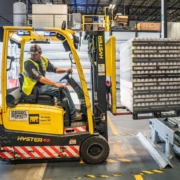The 6 most important warehouse developments.
Challenged by the demands of e-commerce and omni-channel fulfillment, smaller orders, ever shorter delivery times and a persistent shortage of manpower, new solutions are needed for warehouse managers. New warehouse developments are in the pipeline.
At the very least, technology offers some relief. With automation, robotics, artificial intelligence (AI) and other advanced technologies making their way into global distribution facilities, the Warehouse Management System (WMS) is a reliable factor that has long served as a cornerstone for most distribution operations.
But even for all the benefits that WMS is known for, the software’s acceptance rate is around 70%, according to a 2018 WERC survey. “While 30% more facilities implemented a WMS than in 2008,” says the organization, ” Almost 35% are still none for warehouse management, but still rely on spreadsheets and manual registrations, especially in small and medium-sized businesses, even though excellent midsized WMS packages are available for this sector.
Nevertheless, technology is advancing, driven by market pressures. Below are six main trends for the coming year.
1.) Systems that use machine learning to feel and adapt.
WMS has been around for decades. More and more algorithms are being added to properly process order streaming and to serve multiple customers and carriers. If an on-the-go picking process suddenly shifts to a range of hard-to-select items, the system may shift the allocation without human intervention.
2.) Systems that can handle last minute orders.
As the use of wave-less fulfillment in fast e-commerce is gaining in importance, more and more companies are turning to warehouse control systems (WCS) and related automation. These systems enable companies to engage in rush orders while they are still handling peak demand.
3.) WMS suppliers who open up their automation
Cloud computing may have changed the way businesses buy most of their software, from on-premise license purchases to subscription fees, but there are even more creative financing options for companies looking to leverage new technology in their warehouses.
Shippers who try to automate or who invest in robotics, self-guided vehicles and other technology work with their suppliers to come up with creative financing options. In an increasing number of cases, WMS suppliers are working increasingly closely with their OEMs to make the purchase more affordable for a wider range of customers.
4.) Focus on the user interface.
Logistics managers don’t have the time to search a stack of data to find what they’re looking for. Nor do they want to waste their time in determining which information nuggets are “manageable” and which are not.
WMS vendors focus more on their user interfaces and come up with ways to present data to users in a more logical format.
There are now a number of other WMS suppliers who are asking themselves: “How can we enable managers in the warehouse, picking or packing area to do their work better? The focus is on making systems more attractive and user-friendly. Especially in a same-day shipping environment, where a field service representative or store clerk can operate the system without any significant training.
5) Better and faster inventory management.
Today’s consumer has no understanding and patience for late, missing and incorrect orders. They also don’t often think about returning products purchased online and ask for replacement (or refund), even if the item is still perfectly salable.
Businesses should be able to manage perfection while managing individual items more economically. In the field of returns, for example, more companies are rushing to implement the right business processes to deal with these different types of returns. (i.e. those that can be returned to inventory and sold).
A WMS is increasingly becoming an inventory system. While these systems help companies choose, pack and organize, they are also stock systems. When items are returned, shippers must be able to return those goods to inventory. The WMS must also be able to handle that task.
6.) Simplify implementations
More and more suppliers are becoming aware that they have the internal technical expertise to build system functionality that simplifies deployments.
Rather than manually coding data in their WMS platforms, users will use vendor-created wizards and coaching tools to copy templates and then replicate that process across multiple warehouses.
Finally.
As the development of further WMS acceptance slows down, suppliers will incorporate new possibilities and functionalities in their systems. Because many existing warehouse positions are suitable for robotics and automation, it will make sense that even more suppliers are using the new ‘automation wave’.
Automation had been hot for a while, but the first wave of users found it didn’t always pay for itself well. Robotization and automation will therefore continue to advance in warehouses.








